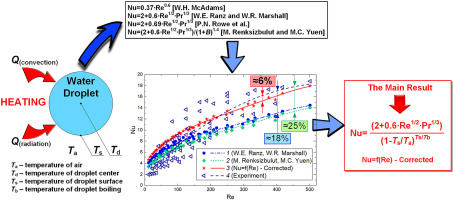当前位置:
X-MOL 学术
›
Int. J. Therm. Sci.
›
论文详情
Our official English website, www.x-mol.net, welcomes your feedback! (Note: you will need to create a separate account there.)
Heat exchange of an evaporating water droplet in a high-temperature environment
International Journal of Thermal Sciences ( IF 4.5 ) Pub Date : 2020-04-01 , DOI: 10.1016/j.ijthermalsci.2019.106227 G.V. Kuznetsov , P.A. Strizhak , R.S. Volkov
International Journal of Thermal Sciences ( IF 4.5 ) Pub Date : 2020-04-01 , DOI: 10.1016/j.ijthermalsci.2019.106227 G.V. Kuznetsov , P.A. Strizhak , R.S. Volkov

|
Abstract In this research, we present the results of experiments capturing the characteristics of high-temperature heating and evaporation of water droplets. The experimental parameters are as follows: initial droplet radius 1–2.5 mm, temperature 20–1100 °C, air flow velocity 0–5 m/s. We use two schemes of water droplet fixation in the heated air flow. In the experiments, we record the heating and evaporation of free-falling droplets so that the holder does not interfere with the experimental results. Typical water droplet heating rates range from 0.4 to 92.4 °C/s and evaporation rates from 0.003 to 0.178 kg/(m2s). Criterial processing of our experimental data is based on the classical equations formulated by Ranz and Marshall and equations proposed by a set of research groups and scientists. We determine the variation ranges of the Reynolds numbers, in which one can only use a limited set of Nu(Re,Pr) correlations. Adjustment coefficients are proposed to take into account the droplet surface temperatures and evaporation rates as functions of the gas medium temperature. Finally, we hypothesize as to how modern mathematical models can be modified to bring the simulation results closer to the experimental data in droplet heating and evaporation rates during fast heat supply.
中文翻译:

高温环境下蒸发水滴的热交换
摘要 在这项研究中,我们展示了捕捉高温加热和水滴蒸发特性的实验结果。实验参数如下:初始液滴半径 1-2.5 mm,温度 20-1100 °C,空气流速 0-5 m/s。我们在加热的空气流中使用两种水滴固定方案。在实验中,我们记录了自由下落液滴的加热和蒸发,以便支架不会干扰实验结果。典型的水滴加热速率范围为 0.4 至 92.4 °C/s,蒸发速率范围为 0.003 至 0.178 kg/(m2s)。我们的实验数据的标准处理基于由 Ranz 和 Marshall 制定的经典方程以及一组研究小组和科学家提出的方程。我们确定雷诺数的变化范围,其中只能使用一组有限的 Nu(Re,Pr) 相关性。建议调整系数将液滴表面温度和蒸发率作为气体介质温度的函数考虑在内。最后,我们假设如何修改现代数学模型以使模拟结果更接近快速供热期间液滴加热和蒸发率的实验数据。
更新日期:2020-04-01
中文翻译:

高温环境下蒸发水滴的热交换
摘要 在这项研究中,我们展示了捕捉高温加热和水滴蒸发特性的实验结果。实验参数如下:初始液滴半径 1-2.5 mm,温度 20-1100 °C,空气流速 0-5 m/s。我们在加热的空气流中使用两种水滴固定方案。在实验中,我们记录了自由下落液滴的加热和蒸发,以便支架不会干扰实验结果。典型的水滴加热速率范围为 0.4 至 92.4 °C/s,蒸发速率范围为 0.003 至 0.178 kg/(m2s)。我们的实验数据的标准处理基于由 Ranz 和 Marshall 制定的经典方程以及一组研究小组和科学家提出的方程。我们确定雷诺数的变化范围,其中只能使用一组有限的 Nu(Re,Pr) 相关性。建议调整系数将液滴表面温度和蒸发率作为气体介质温度的函数考虑在内。最后,我们假设如何修改现代数学模型以使模拟结果更接近快速供热期间液滴加热和蒸发率的实验数据。



























 京公网安备 11010802027423号
京公网安备 11010802027423号